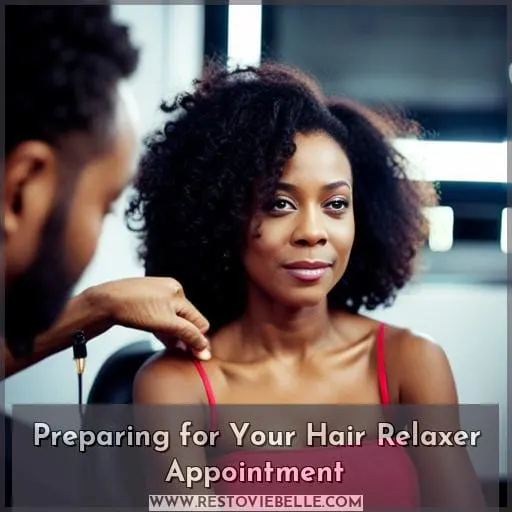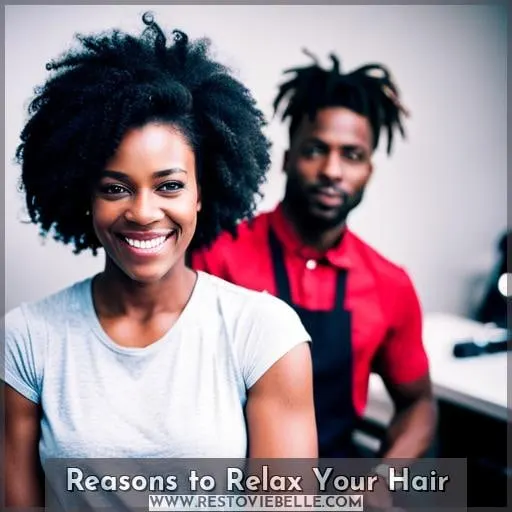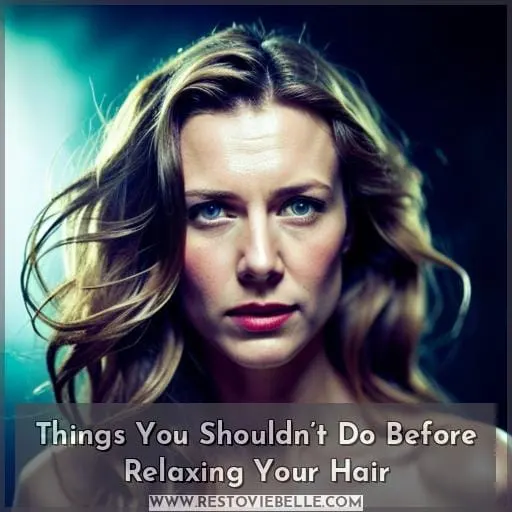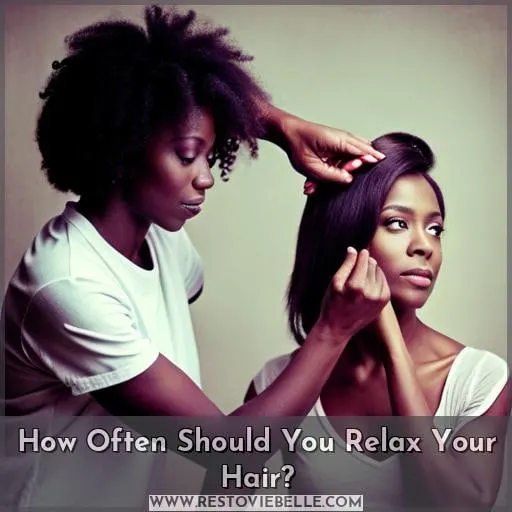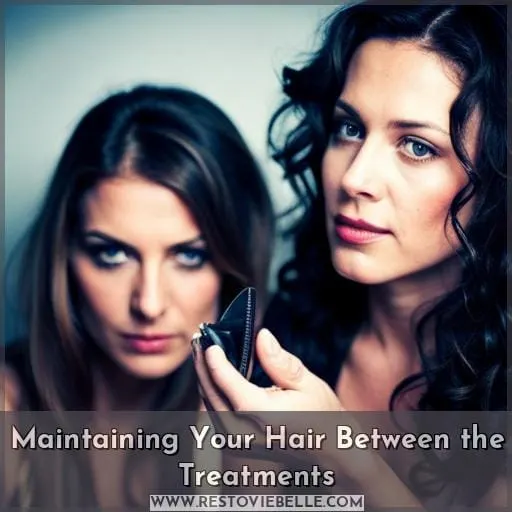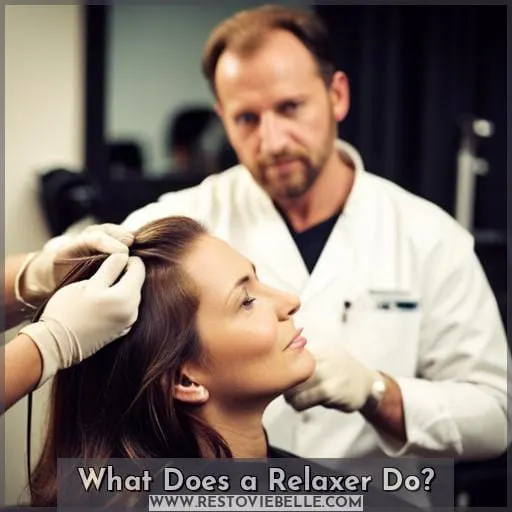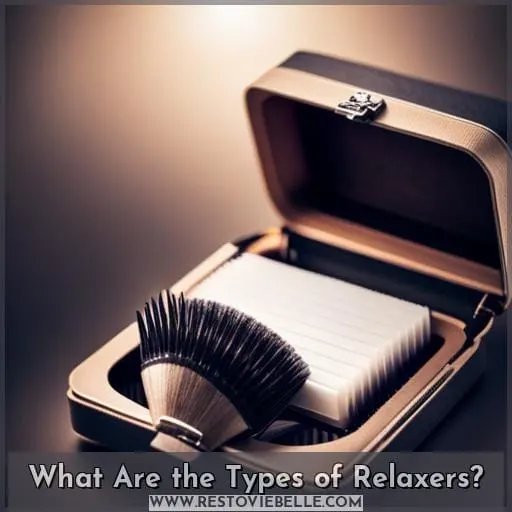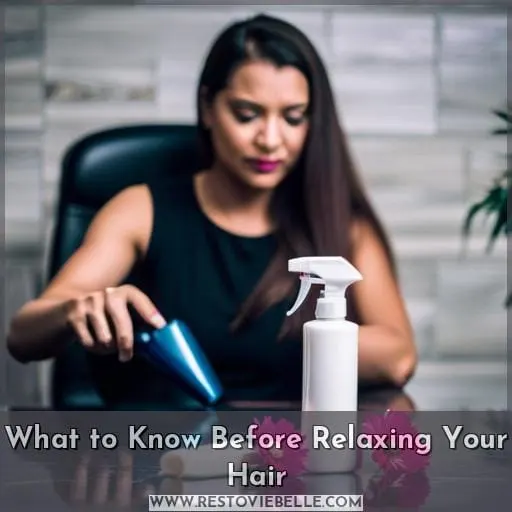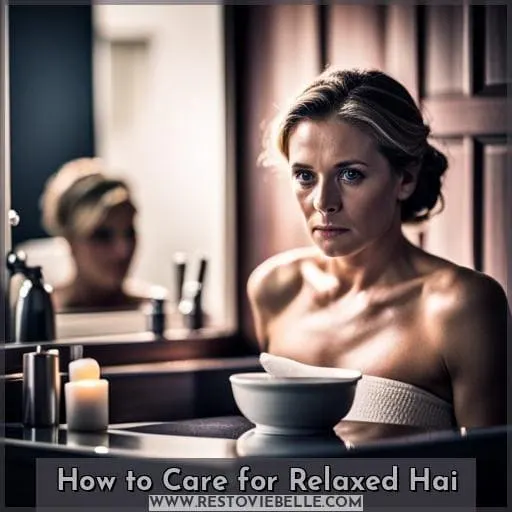This site is supported by our readers. We may earn a commission, at no cost to you, if you purchase through links.
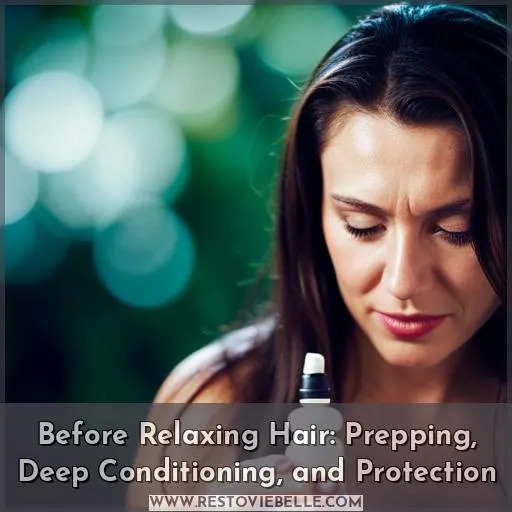 Imagine finally achieving the sleek, smooth hair you’ve always desired. Before relaxing your hair, it’s crucial to properly prepare and protect your strands for optimal results. In this article, we’ll guide you through essential steps such as deep conditioning and scalp protection that will ensure a successful relaxation process.
Imagine finally achieving the sleek, smooth hair you’ve always desired. Before relaxing your hair, it’s crucial to properly prepare and protect your strands for optimal results. In this article, we’ll guide you through essential steps such as deep conditioning and scalp protection that will ensure a successful relaxation process.
By following these expert tips and techniques, you’ll be well on your way to enjoying gorgeous, manageable hair that exudes confidence and style.
Table Of Contents
- Key Takeaways
- Preparing for Your Hair Relaxer Appointment
- The Week Before Your Appointment
- Use a Protein Packed Wash and Conditioner to Deep Condition Your Hair
- Do Not Irritate Your Scalp
- Seal the Moisture Into Your Hair
- The Day Of; Before You Go to Your Appointment
- Part Your Hair Into 4 or More Sections
- Detangle Each Section of Hair
- Use Oils to Protect Your Scalp
- Keep Your Hair Line and the Perimeter of Your Hair Protected
- Protect Previously Relaxed Hair
- Reasons to Relax Your Hair
- Things You Shouldn’t Do Before Relaxing Your Hair
- How Often Should You Relax Your Hair?
- Maintaining Your Hair Between the Treatments
- What Does a Relaxer Do?
- What Are the Types of Relaxers?
- What to Know Before Relaxing Your Hair
- How to Care for Relaxed Hai
- Frequently Asked Questions (FAQs)
- Conclusion
Key Takeaways
- Deep condition hair with protein-rich wash and conditioner the week before the appointment.
- Part hair into 4 or more sections and use a fine-tooth comb to create 1-inch sections.
- Use a wide-tooth comb to detangle hair, working in small sections and avoiding the scalp.
- Protect previously relaxed hair during preparation, avoiding chemical dyes and strenuous activities.
Preparing for Your Hair Relaxer Appointment
Before you go to your hair relaxer appointment, there are several important steps you should take.
First, make sure to deep condition your hair with a protein-packed wash and conditioner the week before your appointment.
Additionally, it’s crucial to avoid irritating your scalp and seal moisture into your hair during this time.
On the day of your appointment, parting and detangling each section of hair is essential for a smooth process.
Lastly, don’t forget to use oils to protect both your scalp and the perimeter of your hair while also safeguarding previously relaxed strands.
The Week Before Your Appointment
To prepare for your hair relaxer appointment, focus on the week leading up to it.
- Deep condition hair.
- Avoid heat styling.
- Avoid scratching scalp.
- Seal moisture in your hair using a protein-packed wash.
Use a Protein Packed Wash and Conditioner to Deep Condition Your Hair
Start by using a protein-packed wash and conditioner to deeply condition your hair.
Deep conditioning with protein-rich products will help restore moisture, strengthen your hair, and improve its overall health.
Protein is essential for repairing damaged strands and promoting growth. Look for deep conditioners that contain ingredients like hydrolyzed keratin or wheat protein to provide the necessary nutrients for your hair.
Apply the deep conditioner evenly throughout your strands, focusing on the ends where damage tends to be more severe.
By incorporating a regular deep conditioning routine into your hair care regimen, you can maintain optimal moisture levels in your tresses while nourishing them with beneficial proteins. This step is especially important before getting a relaxer because it helps prepare and protect the hair from potential damage caused by chemical processing.
Deep conditioning not only provides much-needed hydration but also strengthens weak areas of the hair shafts due to over-processing or heat styling practices that may have compromised their integrity over time.
Consider factors such as porosity (how well your strands absorb moisture) and texture when selecting products suitable for achieving desired results during this pre-relaxer phase of preparation.
Do Not Irritate Your Scalp
Avoid:
- Scratching
- Tugging
- Sweating
- Heat styling
- Harsh chemicals
Seal the Moisture Into Your Hair
First, make sure to seal the moisture into your hair before your hair relaxer appointment.
- Deep condition your hair using a hydrating and nourishing hair mask.
- Consider incorporating a hot oil treatment using a quality hair oil that won’t only seal in moisture but also add shine to your locks.
- Apply leave-in conditioner after washing or moisturizing your strands prior to getting them relaxed. The leave-in conditioner acts as an extra layer of protection against damage caused by chemicals while keeping your tresses manageable throughout the process.
- Lastly, don’t forget about sealing off those vulnerable split ends! Apply a small amount of product specifically designed for sealing ends onto any damaged or frayed sections of the strand before proceeding with relaxing procedures.
This simple step can prevent further splitting and maintain overall healthiness of your hair during the process of relaxing it. It’s important to pay close attention to this aspect as the use of chemicals in the relaxing process can potentially cause dryness and breakage, resulting in hair loss or hair thinning.
In addition, you may consider avoiding significant changes in the intensity or methods of hair color before getting your hair relaxed as incompatibility between products and procedures can generate undesirable outcomes.
By following these steps, you can ensure that your hair is adequately moisturized and protected before your hair relaxer appointment. This will help minimize any potential damage caused by the relaxing process while keeping your tresses healthy and vibrant.
The Day Of; Before You Go to Your Appointment
Before you go to your hair relaxer appointment, part your hair into 4 or more sections.
Part Your Hair Into 4 or More Sections
To prepare for your hair relaxer appointment, start by:
- Parting your hair into 4 or more sections.
- Using a fine-tooth comb to create 1-inch sections.
- Avoiding defined parts.
- Ensuring scalp protection by applying petroleum jelly along the hairline.
Detangle Each Section of Hair
Start by detangling each section of your hair before your relaxer appointment.
- Use a wide-tooth comb to avoid tugging and work in small sections.
- Stay away from the scalp as you comb through all the way to ends.
Use Oils to Protect Your Scalp
Now that you’ve detangled each section of your hair, how can you use oils to protect your scalp during the preparation for your hair relaxer appointment?
Using oils is an essential step in safeguarding your scalp from potential irritation and damage caused by the chemicals in relaxers. There are different types of oils available for this purpose, such as coconut oil, olive oil, or jojoba oil.
Before applying the relaxer, take a small amount of oil and gently massage it into your scalp using circular motions. Make sure to cover all areas where the relaxer will be applied. This protective layer created by the oil acts as a barrier between the chemicals and sensitive skin on our scalps.
When it comes to determining how much oil to use on our scalps before relaxation treatment appointments, it varies depending on personal preferences; however, generally speaking, one tablespoon should suffice per application session while avoiding excess amounts which could weigh down or leave residue behind after rinsing out relaxed strands post-treatment sessions.
In addition to using traditional natural plant-based alternatives like coconut or olive extract-derived products mentioned above, there are alternative choices such as shea butter which has been known to provide similar benefits including moisturizing properties necessary to ensure healthy locks throughout the process duration.
So don’t hesitate to experiment and find what works best for your overall texture, needs, goals, and desired end results.
The benefits provided through incorporating these nourishing substances into pre-relaxation routines include protecting not only just outermost layers but also deeper dermal tissue levels beneath surface, ensuring optimal health from a top-down approach, maintaining balance, hydration, regeneration processes occurring within roots and follicles themselves, promoting longevity, durability, vitality, minimizing risks associated with overexposure to harsh chemical treatments commonly employed today, maintaining sleek, manageable tresses without sacrificing individual style preference.
The journey towards self-discovery, empowerment, and mastery begins right here. Every choice makes a significant impact. Set yourself up for success starting with proper care habits now, and reap the rewards tomorrow: confidence, freedom, exploring, expressing your truest selves and fullest potentials.
Keep Your Hair Line and the Perimeter of Your Hair Protected
Protect your hairline and perimeter by applying base cream or petroleum jelly.
- Use petroleum jelly to create a protective barrier on your scalp.
- Avoid using heat styling tools near your hairline before the appointment.
- Part your hair to ensure even coverage of relaxer and protect edges.
Keep in mind that it’s crucial to take precautions when preparing for a hair relaxer appointment, especially when it comes to protecting delicate areas like your hairline and the perimeter of your hair.
By applying a base cream or petroleum jelly, you can create a barrier that shields these areas from potential irritation caused by the chemicals in the relaxer. Additionally, avoiding heat styling tools near these areas beforehand can prevent any further damage or weakening of already fragile strands.
When parting your hair before application, make sure to section it off properly so that every inch receives adequate coverage while also safeguarding those vulnerable spots along the edges of your head where breakage tends to occur more frequently due to manipulation or tension from hairstyles such as ponytails or braids.
Remember always prioritize keeping both freshly relaxed and previously relaxed sections moisturized throughout their journey with regular deep conditioning treatments following each touch-up session at least once every two weeks (more often if needed).
Protect Previously Relaxed Hair
To ensure the best results, safeguard your previously relaxed hair during preparation.
Reasons to Relax Your Hair
Relaxing your hair can offer several benefits.
It provides a low-maintenance option for styling, reduces frizz and increases shine in your hair.
Detangling frequently, removing extensions and braids before relaxing are important steps to ensure the best results for your relaxed hair journey.
It’s Low Maintenance
Relaxing your hair offers the benefit of low maintenance, reducing styling time and effort.
Enjoy less styling, product usage, damage; more control and versatility.
Less Frizz, More Shine
Achieving less frizz and more shine is one of the benefits of relaxing your hair. To achieve this, avoid heat, deep condition, seal moisture, detangle hair, and protect scalp.
| Tips for Less Frizz | Tips for More Shine |
|---|---|
| Avoid heat styling | Deep condition regularly |
| Detangle hair gently | Seal in moisture with oils or serums |
Can Lead to Less Damage
By relaxing your hair, you can achieve less damage and promote healthier strands in the long run.
Avoid shampooing before a relaxer.
Deep condition your hair.
Protect your scalp and hairline.
Avoid heat styling.
Use oils to protect your hair.
Detangle Your Hair Frequently
To prevent damage and maintain healthy hair, detangle frequently before relaxing.
Use a wide-tooth comb or fingers to work through new growth, avoiding tugging and scratching the scalp.
Avoid workouts that make the scalp sweat heavily.
Remove Extensions and Braids
Removing extensions and braids is essential before relaxing your hair to ensure the best results.
Things You Shouldn’t Do Before Relaxing Your Hair
Before relaxing your hair, there are a few things you should avoid doing.
Firstly, it’s best to steer clear of chemical dyes as they can interfere with the relaxer process and potentially cause damage.
Additionally, try to avoid engaging in strenuous activities that may make your scalp sweat heavily within the 72 hours leading up to your appointment, as this can affect how well the relaxer works on your hair.
Avoid Chemical Dyes
When considering relaxing your hair, it’s important to avoid chemical dyes as part of your pre-relaxing preparations.
Chemical dyes can weaken the hair and make it more susceptible to damage from the relaxer chemicals.
It’s best to wait until after you have relaxed your hair before applying any permanent color or bleach.
Additionally, it’s recommended to avoid heat styling and strenuous activities that may cause excessive sweating on the scalp before relaxing your hair for optimal results.
Avoid Strenuous Activities
Before relaxing your hair, it’s important to avoid engaging in strenuous activities that may cause excessive sweating or irritation to the scalp.
This includes avoiding workouts, especially outside in hot weather or under direct sunlight.
Sweating can lead to moisture buildup on the scalp and potentially affect the effectiveness of the relaxer.
It’s best to give your hair a break from intense physical activity before undergoing a relaxer treatment for optimal results and scalp health.
How Often Should You Relax Your Hair?
Now that you know what not to do before relaxing your hair, let’s talk about how often you should actually relax it.
The frequency of hair relaxing depends on various factors such as the texture and condition of your hair, personal preference, and desired results.
- Every 6 to 8 weeks: This is a common timeframe for touch-ups if you have fast-growing hair or prefer a more frequent refresh.
- 1 to 2 times per year: If you’re aiming for longer stretches between relaxers or have slower growth, spacing them out every few months may be suitable.
- Every 3 to 4 months: For those with moderate growth rates and manageable new growth during this timeframe.
- Every 4 to six weeks: Some individuals with very coarse or tightly coiled textures find it necessary for maintenance within shorter intervals.
Remember that these recommendations are just starting points. It’s crucial to assess the condition of your scalp and strands regularly while consulting with a professional stylist who can provide personalized advice based on their expertise.
Maintaining Your Hair Between the Treatments
To maintain your hair between relaxer treatments, it’s important to follow a few key points:
- Stop using heat on your hair as much as possible to minimize damage.
- Do touch-ups at the right time based on the growth of your new roots.
- Deep condition regularly and avoid shampoos with harsh chemicals that can strip moisture from your strands.
- Incorporate protein treatments into your routine to strengthen and protect your hair from breakage.
Stop Using Heat
To maintain the health of your relaxed hair:
- Refrain from using heat styling tools excessively.
- Deep condition regularly.
- Avoid harsh chemicals.
- Use protein treatments.
- Do touch ups as needed.
Do Touch Ups at the Right Time
To maintain your relaxed hair between treatments, it’s important to know when to do touch ups.
- Timing
- Frequency
- Technique
Deep Condition Your Hair
Deep condition your hair regularly to keep it healthy and nourished between relaxer treatments.
Use heat, protein treatment, oil treatment, and leave-in conditioner for optimal results.
Avoid Harsh Chemicals in Shampoo
To maintain the health and integrity of your relaxed hair between treatments, it’s important to avoid harsh chemicals in your shampoo.
- Sulfates
- Phthalates
- Parabens
- Mineral oil and silicones
Do Protein Treatments
Include protein treatments in your hair care routine to maintain the health and strength of your hair between relaxer treatments. Learn how often, how long, when to do, and what to do for effective protein treatments.
How often:
- Once a week
- Twice a month
How long:
- 15-30 minutes
When to do:
- After shampooing and conditioning
What to do:
- Apply a protein treatment to your hair
- Comb through your hair to distribute the treatment evenly
- Cover your hair with a shower cap or plastic wrap
- Let the treatment sit for 15-30 minutes
- Rinse the treatment out of your hair with warm water
- Style your hair as usual
What Does a Relaxer Do?
Relaxers are chemical treatments that break down the protein structure of the hair, allowing it to become straighter and more manageable.
Here’s what a relaxer does for your hair:
- Temporary Transformation: A relaxer temporarily alters the natural texture of your hair, making it smooth and straight. This allows you to style your hair in different ways without having to deal with frizz or unruly curls.
- Permanent Change: While a relaxer provides temporary results, repeated use can lead to permanent changes in your hair’s texture. Over time, relaxed sections may grow out with new growth appearing as chemically treated strands.
- Chemical Alteration: Relaxers work by breaking down the protein bonds that give curly or coily hair its shape and structure.
By understanding what a relaxer does for your locks, you can make informed decisions about whether this chemical treatment is right for you on your journey towards liberation, power, and mastery over your tresses.
What Are the Types of Relaxers?
As we delve into the topic of different types of relaxers, let’s explore how they can transform your hair. There are several types of relaxers available on the market, each with its own unique composition and benefits.
Here is a table outlining some common types of relaxers:
| Type | Description |
|---|---|
| Chemical | These are traditional relaxers that use chemicals like sodium hydroxide or calcium hydroxide to break down protein bonds in the hair, resulting in straightening. |
| Thio | Thio-based relaxers use ammonium thioglycolate as their main active ingredient to alter the structure and texture of curly or coarse hair. |
| No-Lye | No-lye relaxer formulas contain potassium hydroxide instead of sodium hydroxide for a milder effect on the scalp while still achieving straightening results. |
Keratin Keratin treatments infuse keratin protein deep into strands to smooth out frizz and reduce curliness while maintaining overall health.
By understanding these various options, you can choose a type that best suits your needs and preferences when it comes time for your next relaxing session.
What to Know Before Relaxing Your Hair
Now that you have learned about the different types of relaxers, it’s important to know what steps to take before actually relaxing your hair.
Before diving into the process, there are a few key things you need to keep in mind.
First and foremost, don’t shampoo your hair before applying the relaxer. Shampooing can strip away essential oils from your scalp and make it more prone to burning during the relaxing process.
Next, be sure to detangle your hair thoroughly before starting. Working in small sections, gently comb through each section with a wide-tooth comb or use your fingers first for new growth.
It is crucial that you work with precision when applying the relaxer. Be careful only apply it onto new growth and avoid getting too close to the scalp as much as possible.
Once you have applied the relaxer evenly throughout all sections of hair, let it sit for recommended time listed on packaging instructions without exceeding this timeframe.
After rinsing out thoroughly using warm water (not hot), condition after every rinse session so as not leave any residue behind which could cause damage later down line due dryness caused by harsh chemicals used during processing stage.
How to Care for Relaxed Hai
To care for your relaxed hair, start by:
- Regularly moisturizing and deep conditioning it.
- This will help keep your hair hydrated and nourished, preventing dryness and breakage.
- Additionally, make sure to trim the ends of your hair regularly to remove any split or damaged ends.
- This will promote healthy growth and prevent further damage.
- Another important aspect of caring for relaxed hair is protecting it from heat styling tools such as flat irons or curling wands.
- These can cause excessive damage to already processed hair, so it’s best to avoid them whenever possible.
- Lastly, using a leave-in conditioner can provide extra moisture and protection for your relaxed strands throughout the day.
Frequently Asked Questions (FAQs)
How long should I wait before washing my hair after getting a relaxer?
You should wait at least 48 to 72 hours before washing your hair after getting a relaxer.
This allows the relaxer to fully set and ensures optimal results for smooth, straightened hair.
Can I relax my hair if I have a sensitive scalp?
Yes, you can still relax your hair if you have a sensitive scalp. However, it’s important to take extra precautions and use gentle products specifically designed for sensitive scalps to minimize any potential irritation or discomfort.
Is it necessary to trim my hair before getting a relaxer?
Trimming your hair before getting a relaxer isn’t necessary, but it can help maintain the health and appearance of your hair.
Trimming removes split ends and promotes overall hair growth.
Can I use heat styling tools on my relaxed hair?
Yes, you can use heat styling tools on your relaxed hair. However, it’s important to use them sparingly and with caution to prevent damage.
Make sure to apply a heat protectant before using any hot tools.
How often should I deep condition my hair after getting a relaxer?
After getting a relaxer, deep condition your hair once a week to restore moisture and maintain its strength. Think of it as nourishing your strands like a refreshing oasis in the desert heat.
Conclusion
To achieve the sleek, smooth hair you’ve always desired, proper preparation and protection are essential before relaxing your hair. By following the expert tips and techniques outlined in this article, you can ensure optimal results and enjoy gorgeous, manageable hair that exudes confidence and style.
From deep conditioning and scalp protection to detangling and oil application, every step plays a crucial role in the success of your hair relaxation process.
